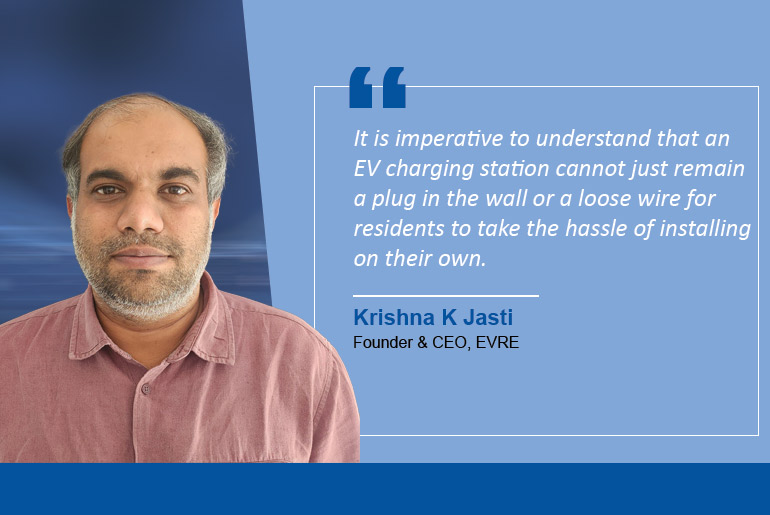The global emphasis on electric vehicles (EVs) is comparable to the early 18th-century innovation of the steam engine. Moving away from conventional mobility solutions has historically been a significant movement for humankind as a civilization, and the ongoing focus of shifting from ICE vehicles to EVs aligns with this. However, while EVs have become the talking point of the town, the EV charging sector has witnessed similar growth, but the scope of work and progression remains much higher and critical than the EV sector — particularly as a catalyst for driving EV adoption across the globe, especially in emerging markets like India.
Many reports have suggested that in Indian urban centres, a significant percentage of EV owners reside in housing estates or societies, with limited or no means of charging for their vehicles. These aspects highlight glaring gaps in India’s EV charging infrastructure, and addressing these concerns will significantly bolster private EV adoption in the country. Furthermore, development efforts in the space have led to state-of-the-art smart AC chargers that are not only more efficient than their predecessors but also provide an ideal balance of speed, convenience, safety and scalability. However, these advanced technologies cannot remain distinct anymore for residents, meaning a considerable focus might be next to installing them in bulk in housing societies to attain absolute EV adoption.
Why AC Smart chargers are required in housing societies
Before understanding the importance of functional EV charging infrastructure in residential societies, it is imperative to understand that EV chargers are primarily divided into two categories — AC and DC chargers. The public charging stations in cities, or highways that offer fast and ultra-fast charging include DC chargers that require significantly more power than typical home electrical systems. On the other hand, AC chargers take significantly more time to complete the charging process, however, they are highly cost-effective and can be integrated with existing electrical infrastructure — making them the preferred solution for residential usage.
Smart features, as the name suggests, are just intelligent technologies that are far superior than earlier versions of the technology. With smart AC chargers, two-fold advantages can be availed, leading it to become a mutually beneficial technological integration for both builders and residents.
For instance, smart AC chargers are capable of managing power load and phase seamlessly, ensuring reduced peak power usage and eliminating phase imbalance. Also, these chargers are factory-equipped with enhanced features like remote management / OTA features that offer better monitoring, diagnostics and timely maintenance — leading to a more comprehensive experience and reduced downtime. With smart AC chargers, effective billing can be attained through integration into building management systems. This means that these smart AC chargers become a part of the larger residential electrical system that supports the lights, fans or other electrical appliances, directly translating to a more seamless EV charging experience.
The ease of integrated payments in these chargers, safety & protection measures, and offline charging availability all provide a much better charging experience than depending on public chargers, enabling a resident to charge any time. It is imperative to understand that an EV charging station cannot just remain a plug in the wall or a loose wire for residents to take the hassle of installing on their own. A housing estate where a holistically thought out EV charging system offers much better ease of access and value-for-money aspects to modern users — directly translating to have a positive impact on increasing EV adoption.
Housing estates & smart AC chargers
Recent reports suggest that one in three Indian families have a two-wheeler, whereas 8% of Indian families have a car. At the same time, EV sales in India touched 2.2 million in 2024, a significant 27% growth compared to 2023, as EVs form 7.7% of the broader automobile sector. Even if we take a more modest figure of sales growth, the country is estimated to witness at least a growth of somewhere between 25-30% in the next 5 years — meaning the country will require at least 3.9 million chargers to accommodate these vehicles.
This is where housing estates and smart AC chargers come into play. Depending on size, residential complexes in India can accommodate anywhere between 10 – 200 families, a significant portion of whom have already adopted EVs or are in the process or contemplating adopting EVs in the coming years. With dedicated smart AC chargers as part of the residential complexes, EV adoption becomes seamless, offering benefits to both residents regarding convenience and builders with demands. Furthermore, this helps to decongest public charging stations, enabling industry stakeholders with enough time for maintenance for reduced downtimes. As large residential buildings equip smart AC chargers, it also offers a cost-effective solution for EV owners, giving them the option to charge their vehicles in the comfort of their homes overnight or during the day at their convenience.
Smart AC chargers can be set up in large residential projects easily, however, by planning to install them at the design stage, it saves a lot of complexities and cost. Planning during designing stages help to allocate space in parking areas, pre-route conduit and wiring to avoid rework and with an estimated 50-70% adoption in the coming years — it provides builders the flexibility. Another aspect of planning during the designing stage helps builders to assess the power load requirements and choose the right chargers (Level 2 AC smart chargers in most cases). This also enables the Dynamic Load Management aspect — helping the builders to support more chargers without requiring any transformer upgrade, automatically balancing loads, reducing infrastructure costs and enabling scalable EV charging station setups. This leads to a much more streamlined approach for setting up EV charging stations at large residential societies — positioning India as one of the fastest EV adopting countries in the world.

